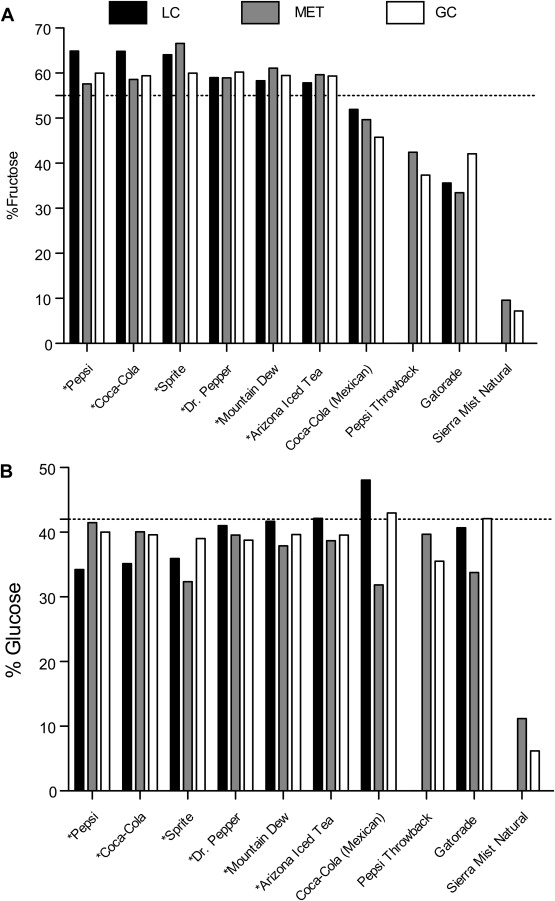Researchers at the Keck School of Medicine of the University of Southern California say that though fructose is naturally found in numerous fruits and other products, it is not only harmful, the public is being lied to about it on labels.
High fructose corn syrup (HFCS) has long been a target for food activists. Though we live in a world where over 90% of added sugar is sucrose (table sugar), some believe HFCS in soda is causing American obesity. But it can only be American obesity, since much of the world does not use it in soda.
The HFCS disaccharide in common production contains 45 percent glucose (monosaccharide) and 55 percent fructose (an isomer of glucose - same chemical structure, different physical one) whereas white sugar is split about evenly, 50-50 between glucose and fructose. Corn syrup is 100 percent glucose. Some types of HFCS, such as in certain breads, are 58 percent glucose and only 42 percent fructose. The new analysis found a fructose to glucose ratio of 60:40, 10 percent higher than the claimed standard for HFCS and they believe that challenges the industry's claim that "sugar is sugar."
"We found what ends up being consumed in these beverages is neither natural sugar nor HFCS, but instead a fructose-intense concoction that could increase one's risk for diabetes, cardiovascular disease and liver disease," said Michael Goran, Ph.D., director of the Childhood Obesity Research Center (CORC) and lead author of the study. "The human body isn't designed to process this form of sugar at such high levels. Unlike glucose, which serves as fuel for the body, fructose is processed almost entirely in the liver where it is converted to fat."
Which is true, to a point. Pure fructose has been shown to cause metabolic upset at high concentrations, such as when it is the sole carbohydrate source, but such extreme carbohydrate diet studies were only useful for probing biochemical pathways, they had no relevance to the human diet or to current consumption. There has been no causal link between HFCS and obesity, though people in developed nations worldwide generally consume too much sugar.
The USC paper also claims product labels are lying about fructose content. Though the label says it is made with sucrose, their analysis of Pepsi Throwback found it contains more than 50 percent fructose. Sierra Mist, Gatorade and Mexican Coca-Cola also have higher concentrations of fructose than their labels. They can't prove it so they simply suggest these beverages might contain HFCS, which is not disclosed on their labels, but their message is clear.
The first question that needs to be asked is, how old were these samples? The study just says they were chosen by popularity and purchased in East Los Angeles. After about 30 days, what will sucrose in soda revert to? Individual fructose and glucose. They had them analyzed for sugar composition in three different laboratories using three different methods, liquid chromatography, a metabolomics-type MET approach based on mass spectrometry with combined liquid and gas chromatography and gas chromatography.
But they found the results were consistent across the different methods and yielded an average sugar composition of 60 percent fructose and 40 percent glucose in beverages made with HFCS. Thus their claim that the added sugar is not even HFCS and that the labels are lying.

Mean sugar comparison of sodas across three independent methods. Panel A displays percent of total sugar shown to be free fructose in soda/sports drink products. The dashed line represents 55% fructose expected of HFCS-55. Panel B displays percent of total sugar shown to be free glucose in soda/sports drink products. The dashed line represents 42% glucose expected of HFCS-55. Bars represent methodology used to determine sugar profiles: LC=liquid chromatography, MET=metabolomics and GC=gas chromatography. Credit: 10.1016/j.nut.2014.04.003
Americans consume more HFCS per capita than any other nation and consumption has doubled over the last three decades. Diabetes rates have tripled in the same period. They believe HFCS specifically is the reason for that but estimates are that added sugars represent 16 percent of daily calories, so switching to sucrose would not help. Those 300-400 calories are still too much empty addition.
"Given that Americans drink 45 gallons of soda a year, it's important for us to have a more accurate understanding of what we're actually drinking, including specific label information on the types of sugars," said Goran.
Critics will likely contend that since the funding source was the Dr. Robert C. and Veronica Atkins Foundation, a complementary medicine advocacy group founded by the controversial popularizer of the Atkins Diet, the results will need to be replicated with more control over the soda.
But sodas may not be the biggest culprit anyway. Minute Maid and Juicy Juice 100% apple juices had Fructose:Glucose adjusted values of 67.1 and 67.3, respectively, the highest in the study, and and five other juices also had Fructose:Glucose adjusted values higher than 55.
Source: University of Southern California - Health Sciences






Comments